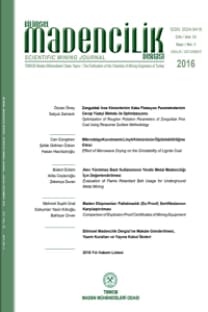Hasançelebi Demir Yatağında Manyetit Dağılımı-Derinlik İlişkileri
Hasançelebi demir yatağında değer taşıyan başlıca mineral manyetittir. Milyar-ton düzeyinde jeolojik
rezerve sahip olan yatağın ekonomik değerini bu mineral saptamaktadır. Manyetitin yatak
içersindeki dağılımı son 2 yd içinde oldukça ayrıntılı bir şekilde incelenmiş ve küçük hacim birimlerindeki
içeriğinin bîr envanteri çıkarılmıştır (Kaynak 1). Bu envanter esas alınarak, yatağın çeşitli
bölgelerinde manyetit dağılımı ile derinlik arasındaki ilişki polinom regresyonuyla araştırılmıştır.
Polinom regresyonu tek tek sondajlara ve cevher kitlelerine ait verilere uygulanmıştır. Kitle regresyonununda
olsun, tek tek sondajlannkinden olsun, genel karakteristikleri birbirine benzeyen belirli
polinom bağıntılarının var olduğu saptanmıştır. Genel karakteristikleri benzer olmakla birlikte,
bağıntıların istatiksel güvenilirlikleri farklı bulunmuştur.
Yatağın belli başlı bölgelerinde bağıntıların çok kuvvetli ( güvenilir) olması, bunlardan değerlendirme
çalışmalarında yararlanılması olanağını yaratmıştır,. Daha önce eksik bilgiyle hatalı değerlendirilen
bazı seviyeler böylece saptanabilmiş, yatağm, oluşumundan sonra aşınma ile taşınmış ki- .
sımları hakkında da tahmin yürütmek olasılığı doğmuştur. İlerde başka pratik değerlendirmelerin
de, bu bağıntılar yardımıyla yapılabileceği ümit edilmektedir.
The principal mineral of value in Hasançelebi ore deposit is magnetite. It is magnetite that determines
the economical value of the deposit which has ore reserves in the billion ton order with average
17 % magnetite. During the past two years, distribution of magnetite within the orebody was
investigated intensively and an inventory of magnetite content and its grade distribution within the
unit volumes of a block grid system woe prepared. Based on this inventory, relationships between
magnetite content and depth for various portions of the orebody were investigated, using the
polynomial regression technique.
Polynomial regression was applied to individual drill hole information as well as to mass data. In
both cases, it was determined that certain polynomial relationships prevailed between magnetite
content and depth (or elevations). General characteristics of these polynoms were similar. However,
their statistical reliabilities varied.
That these relationships were very strong for major portions of the orebody provided the
opportunity to use the regression results in the evaluation work. It was possible to point out the ore
levels which seemed to have been erroneously evaluated in the previous work due to scant drül hole
information. Results also helped making estimates on the eroded portions of the orebody. It is
hoped that in the future, other practical evaluations from these results will be possible.
- ISSN: 2564-7024
- Yayın Aralığı: Yılda 4 Sayı
- Yayıncı: TMMOB Maden Mühendisleri Odası
